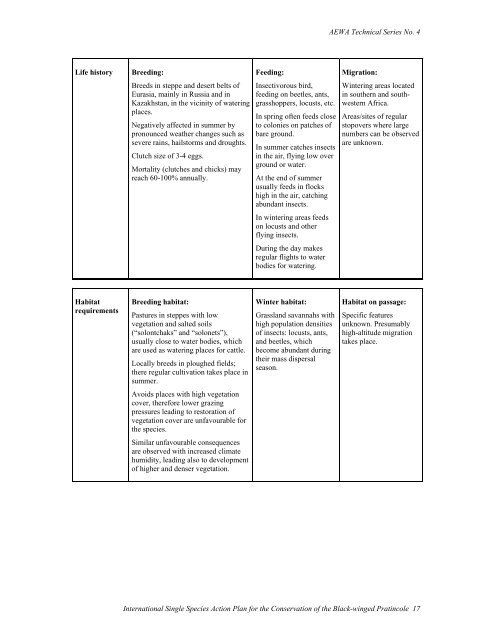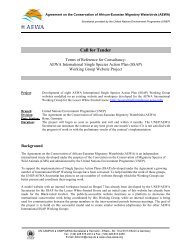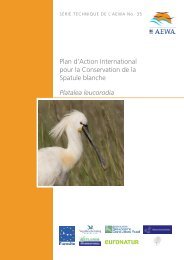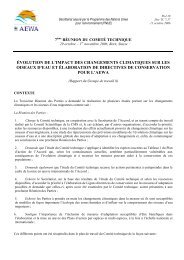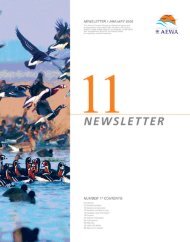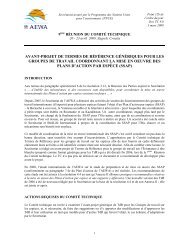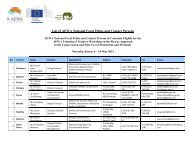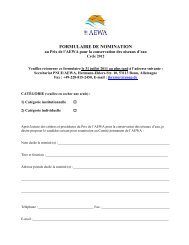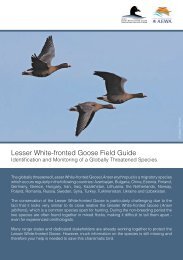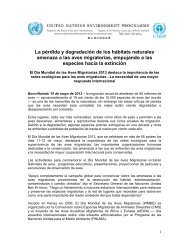Black-winged Pratincole - AEWA
Black-winged Pratincole - AEWA
Black-winged Pratincole - AEWA
Create successful ePaper yourself
Turn your PDF publications into a flip-book with our unique Google optimized e-Paper software.
<strong>AEWA</strong> Technical Series No. 4<br />
Life history<br />
Breeding:<br />
Feeding:<br />
Breeds in steppe and desert belts of<br />
Eurasia, mainly in Russia and in<br />
Kazakhstan, in the vicinity of watering<br />
places.<br />
Negatively affected in summer by<br />
pronounced weather changes such as<br />
severe rains, hailstorms and droughts.<br />
Clutch size of 3-4 eggs.<br />
Mortality (clutches and chicks) may<br />
reach 60-100% annually.<br />
Insectivorous bird,<br />
feeding on beetles, ants,<br />
grasshoppers, locusts, etc.<br />
In spring often feeds close<br />
to colonies on patches of<br />
bare ground.<br />
In summer catches insects<br />
in the air, flying low over<br />
ground or water.<br />
At the end of summer<br />
usually feeds in flocks<br />
high in the air, catching<br />
abundant insects.<br />
In wintering areas feeds<br />
on locusts and other<br />
flying insects.<br />
During the day makes<br />
regular flights to water<br />
bodies for watering.<br />
Migration:<br />
Wintering areas located<br />
in southern and southwestern<br />
Africa.<br />
Areas/sites of regular<br />
stopovers where large<br />
numbers can be observed<br />
are unknown.<br />
Habitat<br />
requirements<br />
Breeding habitat:<br />
Pastures in steppes with low<br />
vegetation and salted soils<br />
(“solontchaks” and “solonets”),<br />
usually close to water bodies, which<br />
are used as watering places for cattle.<br />
Locally breeds in ploughed fields;<br />
there regular cultivation takes place in<br />
summer.<br />
Winter habitat:<br />
Grassland savannahs with<br />
high population densities<br />
of insects: locusts, ants,<br />
and beetles, which<br />
become abundant during<br />
their mass dispersal<br />
season.<br />
Habitat on passage:<br />
Specific features<br />
unknown. Presumably<br />
high-altitude migration<br />
takes place.<br />
Avoids places with high vegetation<br />
cover, therefore lower grazing<br />
pressures leading to restoration of<br />
vegetation cover are unfavourable for<br />
the species.<br />
Similar unfavourable consequences<br />
are observed with increased climate<br />
humidity, leading also to development<br />
of higher and denser vegetation.<br />
International Single Species Action Plan for the Conservation of the <strong>Black</strong>-<strong>winged</strong> <strong>Pratincole</strong> 17


